-
Home
-
Puppy Development Stages
>
by Janice Jones |Last Updated 04-23-2021
People often think of their small dogs
as babies and themselves as parents.
Parents want to understand puppy development so they can predict what comes
next.
Just like human development, puppy
development follows a predictable sequence, but unlike children, dogs
pass quickly through these phases.
Yes, puppies grow up fast. In the wink of an eye, your little puppy will
become an adult, so as a puppy parent, you don’t have much time to loose.
Small dogs,
in particular, mature fast, much faster in fact than even large breed
dogs. By the time they are ten months
old, many small breed dogs have achieved adult reproductive status and look and feel like an adult dog.
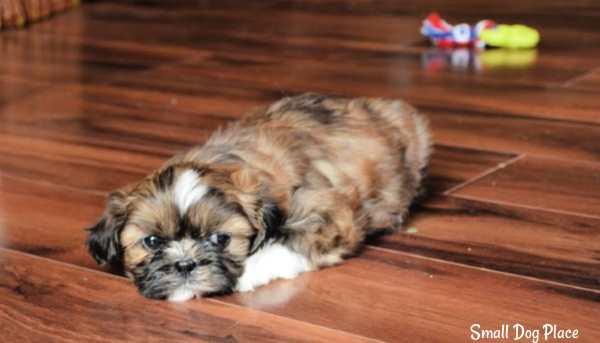 Puppy Development Stages
Puppy Development StagesExperts cannot agree
upon exact ages as some breeds and even dogs within breeds develop at different
rates. But the stages of development are
predictable.
There are seven stages of puppy development not including the adult
stage.
Puppy Development Stages
- Neonatal Period: Birth to Two Weeks
- Transitional Period: Two to Three Weeks
- Awareness or Identification Period:
Three to Four Weeks - Second Awareness or Identification: Four to Five Weeks
- Socialization Period: Five to 16 Weeks
- Flight Instinct Period: 4-8 Months
- Second Fear Impact Period: 6-14 Months
- Maturity: 1-4 years
During the Socialization Period, there are several sub-phases
- Curiosity: 5-7 Weeks
- Behavioral Refinement: 7-9 Weeks
- Fear Imprint/Impact: 8-11 weeks
- Environmental Awareness: 9-12 Weeks
- Seniority Classification Period 13-16 Weeks
Puppy Development Stages: Neonatal Period (Birth – 2 weeks)
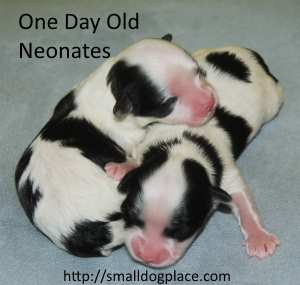
At birth, your puppy’s eyes and ears
are closed. In fact, only 3 senses are working—touch, taste, and smell
and even then they are not entirely
developed. Puppies feel and respond to pain, discomfort and minor
disturbances by whining or crying.
Their body temperature is well below
that of a mature dog, and they are unable to tolerate a cold environment.
Neonates
have a body temperature of about 94 to 96 degrees F. The normal temperature for
older puppies and adults is 101-102 degrees F.
For optimal puppy
development, the room temperature must be kept hot and breeders accomplish this
by maintaining room temperatures around 80 degrees and providing heating lamps
and/or heating pads.
Puppies of this age are also
incapable of either urinating or defecating on their own and depend on their
mother to stimulate this process.
Their first mission in life is to
find warmth and food. They have no teeth, but their nails are fully developed
and some may even need trimming in the first week of life. Their primary activity at this time is to search out
nourishment from their mom and sleep.
Newborn puppies sleep most of the time,
often as much as 90% of their time. While asleep they often twitch and move only to re-position their body.
Twitching
occurs because at this point in their young lives, they sleep is the REM stage,
a stage characterized by high brain activity.
Beyond that, they have
little interaction with litter-mates or
the environment other than to huddle close to litter-mates and mom for
warmth.
The mother
dog provides the warmth, the food, and cleans up after all pottying activity, a
job that mother dogs accept happily.
Puppy Socialization should begin the day he is born and continue throughout puppyhood. It is up to the breeder to provide this type of stimulation so that the puppy becomes a well adjusted adult.
Barking is weeks away, but small
vocalizations can be heard that resemble whining or crying. Neonates will vocalize if they are being laid
on, hungry, or in distress.
Puppy Development Stages: The Transitional Period (2-3 weeks)
At around two weeks of age, the puppy’s
eyes open and then several days thereafter, their ears open. At first
their vision is blurry but soon vision improves and the puppies can now see the
world at least from their vantage point.
Once their ears open they may
begin to startle when they hear sounds. Even from the very beginning,
their range of hearing is nearly twice that of humans and into the ultrasonic
range.
At three weeks of age, puppies become
somewhat adventuresome and begin to move
around more, though they are not very sure footed at this age. This might
be equivalent to the crawling stage in the human infant.
Their eyesight
and hearing are improving daily. This is also the time that they begin to
lap liquids and mouth solid foods if the consistency is mush-like.
They also begin to
have limited interaction with litter-mates.
The majority of this interaction revolves around who is going to serve
as a pillow and who is going to serve as blanket as they pile up in one small
corner of the whelping box.
Puppies take turns sleeping on
top of the pile and cuddling underneath and don’t seem to mind either position.
They also begin to paw at each other and may try to bite at each others faces.
The initial eruption of teeth occur by
the end of the period, but there won’t be enough teeth to manage hard kibble
for several more weeks.
Sometime
during this phase, they are able to eliminate on their own and will start to
crawl out of their whelping box to
eliminate.
Puppy Development Stages:
Awareness or Identification Period (3-4 Weeks)
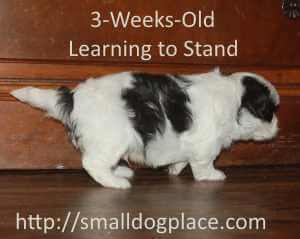 Puppy Development Stages: Awareness
Puppy Development Stages: AwarenessNow, the puppy has all of his senses
and the environment takes on a greater meaning.
They become aware that they are dogs and have litter-mates. They also
discover that humans are part of their environment.
By four weeks of age, most puppies have
figured out what “real” food is and continually eat more dog food, nursing
less. They are however, far from being weaned at this age. It is
important to start them on a good high quality dog food.. Feeding puppies becomes the responsibility of the breeder.
They are moving around more and sleeping
less.
At four weeks,
he is also beginning to regulate his own temperature and feel the urge to pee
and poop on his own. He won’t always need Mama to stimulate him to go
potty, yet most good moms continue to clean up after their pups at least for a
while.
If given an opportunity, puppies will pee or poop on a puppy
pad.
A little play-fighting emerges within
the group. Puppies discover their voice
and vocalizations become louder. A small
bark can be heard for the first time and some will also begin to howl.
Puppies still struggle to nurse, but
mama often makes herself scarce. A small
growl or a show of teeth by the mother lets the puppies
know what discipline is all about.
Nevertheless, nursing can continue up to 10 to 12 weeks in small breed
dogs.
Puppy Development Stages:
Second Awareness or Identification (4-5 weeks)
 Puppy Development Stages: Second Awareness
Puppy Development Stages: Second AwarenessThe gentle sibling interactions of last week turns into a much more rigorous play that includes
growling, chasing, and wrestling.
They
discover toys and will investigate any new object placed in their path. They will grab a small object and run with
it, chew on it or use it in a tug of war game with a litter-mate.
If given the opportunity, they will develop problem-solving
skills and learn how to cope with a little frustration.
By now, the puppies are
feeling very confident in their familiar environment. A pecking order develops but may change from
day to day. The alpha dog on Tuesday is
not the same one on Wednesday. But, when
puppies are taken away from their safe place, a totally different personality
develops.
Some become frozen
with fear at first, and others venture out with zeal. Most are somewhere in the middle, cautious at
first, but then curious and interested in their new surroundings.
Puppy Development Stages: Socialization Period (5-16 weeks)
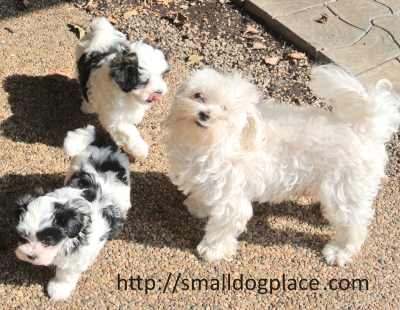 Puppy Development Stages: Socialization
Puppy Development Stages: SocializationBy five weeks of age, he has reached
the toddler stage of puppy development and will become very busy interacting
with litter mates and of course humans.
Mama will try to encourage her
youngsters of this age to wean, making herself less available for free drinks
at any time of the day. Some moms actually regurgitate food for their
young, although this is not seen very
much in domestic dogs.
At six weeks of age, puppies are ready
for their first shots and they should have already had a couple of wormings by
now to deal with internal parasites. The tiny breeds may not get their first shots until around the age
of 8 weeks. Their play takes on new
dimensions and toys become fascinating objects.
Puppies want to explore and will find
ways explore every inch and cranny of their allotted space. During this
period, breeders should continue to offer stimulation in the form of sounds,
smells, and textures and provide exciting
environments for puppies to explore. Mama continues to teach her puppy
manners especially “bite suppression.
Puppies learn what appropriate canine
behavior is and is not through the use of play and observing other canine body
language. These actions will be repeated
for two weeks until they become fully weaned and ready to go to their forever
home.
Smaller breeds such as Yorkshire terriers, teacup
toy poodles, and Chihuahuas may need more
time with mama and the litter mates. A puppy of 6 weeks is curious,
friendly, outgoing and fully ready to learn. If socialized correctly he
will be completely ready and eager to please his new human family when that
time comes.
But beyond the confines of the puppy
pen lies a whole new world that they must learn to master. Socialization during
this period is critical for normal adult functioning.
Researchers have shown that the brain
atrophies if a dog is raised in an environment void of sensory
stimulation. The more enriched the
environment is during this stage, the better able the puppy will do as an
adult.
According to Pat Hastings, editor of
Puppy Development, socialization does two things for the puppy. First it reduces the number of things a pup
might become frightened of and it provides the experience of being frightened
and then recovering. Under socialized
puppies grow up to be adult dogs that are shy, fearful,
unable to discriminate threats and
even become aggressive.
Socialization is a continuing process that should last a
lifetime, but it usually doesn’t because people are busy, there are limited
places a dog is allowed to go and places that do allow dogs are often filled
with pathogens that cause disease. Good
protection in the form of immunizations will help protect dogs from serious
diseases.
The socialization period is further divided into distinct
sub-catagories.
Puppy Development Stages: Curiosity Period (5-7 weeks)
The video above was made for my other website, but shows the development of the puppies pictured on this page. They are called Mal-Shi and are one half Maltese and one-half Shih Tzu.
Puppies have little sense of fear now and will want to
investigate everything. Climbing on,
crawling through and tasting everything in their path.
Puppies readily accept people with little fear. Temperaments are beginning to emerge and some
breeders will use temperament testing such as the Puppy Appitude Test developed
by Volhard.
Puppy Development Stages:
Behavioral Refinement Period (7-9 weeks)
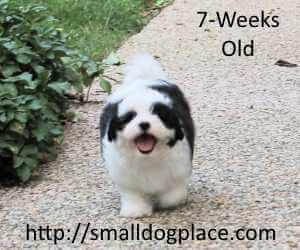 Puppy Development Stages: Behavioral Refinement
Puppy Development Stages: Behavioral RefinementAt eight weeks of age, many small breed
puppies are ready to go to their new home. Others will stay with their canine
mother and breeder for another 4 weeks. This applies primarily to the smallest of the toy breeds.
The puppy has an extremely short
attention span but a fully function brain, capable of learning anything. At eight weeks of age, the puppy is a small
version of what it will look like as an adult.
Many breeders, in the U.S. at least agree that it is the best time to go
to their new home. Whether a puppy goes
to a new home at eight weeks or remains with the breeder depends on who is the
best equipped to socialize and train the puppy at this most vulnerable stage.
Puppy Development Stages:
Fear Imprint/Impact Period (8-11 weeks)
At eight weeks, the puppy begins to experience caution in his action.
At previous stages of puppy development, he was exuberant and reckless,
charging forward without any fear.
During the next couple of weeks, the
puppy becomes cautious and checks everything out. It is important that
new owners let nature take its course as the puppy will get through this stage
and move on relatively quickly and unscathed.
It
is also important that owners not “cuddle and baby” the puppy during this time, but rather assure for the puppy’s safety,
but not jump in to rescue them unnecessarily.
Some puppies develop fear and anxiety issues if
allowed to be “saved” during this time
that are hard to correct later on. Naturally, if a puppy is in danger of being
harmed, quick intervention is important.
If the puppy goes to his new home
during this time, the first few nights will be hard
for the little guy as he has not had too much experience being on his
own.
If frightened during this period, it
might take weeks to return to normal.
Many people argue that this may not be
the best time for home changes, traumatic visits to the vet, shipping, or harsh
discipline. Rather this is the time that the puppy should be exposed to many
positive experiences.
The more new sights, sounds, and smell, that he can experience the better but within a safe
environment. Puppies that have lots of
socialization experiences and stimulus during this period will be much better
equipped to handle change as they grow.
Sometime around eight weeks of age, the
puppy is ready for their first immunizations if they were not vaccinated at six weeks of age.
They should already have been wormed for intestinal parasites.
Puppy Development Stages:
Environmental Awareness Period (9-12
weeks)
 Puppy Development Stages: Environmental Awareness Period
Puppy Development Stages: Environmental Awareness PeriodBonds become very strong during this
phase. If the puppy spends most of his
time with his litter-mates, he will bond very closely with them and have a
difficult time spending time with humans.
Their dog to dog social skills will be strong, but show shyness or fear around people.
If there time is spent bonding with
humans and separated from other dogs, the human bond is strong, but the puppy
may not develop good skills with other dogs.
Ideally, a mix of human and dog interaction is the most beneficial for
the puppy.
As new owners take on the responsibility of dog parents, they often wonder how big their puppy will get. Most purebred dogs fall within a framework that helps the owner know what to expect. Even within the same litter, however, there can be variation.
I found an interesting resources that helps you predict what your puppy’s height will be as an adult. At the Puppy Height Calculator, you can learn how to measure your puppy’s height and it will let you know how tall they are full grown.
Puppy Development Stages:
Seniority Classification Period (13-16
weeks)
This is considered to be the puppies
“tween” stage because the first signs of independence are noticeable. We call this the preteen stage in human
development. This is a very demanding stage of puppy development and the
well-behaved little guy who stuck right by your side will suddenly want to
ignore you and do his own thing.
Behavior is a bit erratic during this period and tends to fluctuate
from being a sweet, cuddly baby to a stubborn teen. Teething begins in
earnest and the
puppy tries to find anything and everything to chew upon, whether it is a
favorite wooden chair or a person’s toes. A puppy might bite for the
first time in an effort to do his own thing. Having a puppy-proofed house is important during this phase.
This is the time when potty training
usually occurs and beginning obedience training such as how to walk on a leash,
not necessarily how to heel. It is also
a time when the puppy must learn what is expected of him. It is never too early to begin informal basic command training. If he’s allowed to “bite” because it doesn’t
hurt, dominate other pets, or resist human interactions such as nail clipping. If these important lessons are not learned,
it will be more difficult later on correct bad behaviors.
Some behaviorists believe that end of
the socialization period (4 months) effectively closes the window of
opportunity for the puppy to benefit from these early attempts at
socialization: skills training, exposure
to many different things, people and places and learning right from wrong.
Puppy Development Stages:
Flight Instinct Period (4-8 months)
As the name implies, this period spells
an abrupt change in your otherwise small, lovable (“Velcro”) dog. As with human teenagers, puppies feel the need
to test their wings and will wander farther away or may even take off unexpectedly while off leash.
Now, this
wouldn’t pose a real problem if there were no dangers and the puppy came
immediately when called.
The perfect recall is rarely achieved during
this period. Puppies remind me of the
old folk tale, the Gingerbread Man. If
you have an especially fast breed, the chances are that he could be a city
block away before you realize he’s taken off.
Attitude is everything during this adolescent period. The dog tries to break all the rules if given the opportunity and
test the limits. People often call their dog stubborn, disobedient, and
testy.
Fortunately, this phase does not last
long. For some, it goes on for days or
weeks, but rarely does it last a month or more.
Even the low energy breeds go through this stage, so knowing that it
will happen can help you prepare. A long
leash outside or one of those retractable ones will keep him near you and away
far from harm’s way.
Run, run, as fast as you can, you can’t
catch me,
I’m the Gingerbread Man!
(ahhh, I’m the PUPPY!)
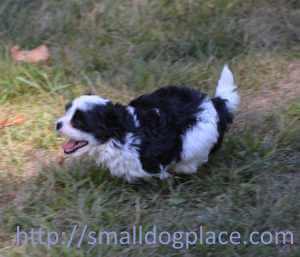 Puppy Development Stages: Flight Instinct
Puppy Development Stages: Flight InstinctPuppy Development Stages:
Second Fear Impact Period (6 to 14
months)
This period is hard to define. The puppy may go through it during a time of
rapid growth or may occur when the puppy encounters a new situation. It is likely that the onset of sexual
maturity and the surge of sex hormones may have something to do with this
phase.
A happy dog that loves people suddenly
fears them. The dog that walked easily
into the veterinary clinic, suddenly rebels pulling forceful away from the
door. The dog that seemed fine one day,
reacts poorly to some imagined fear.
Beyond the fear issues, the period from
six months to 14 months also heralds in sexual maturity. Girls go into heat for the first time and can
mother a litter. Boys will show interest
in female dogs, lift their leg to urinate and may mark urine inside and
out. They may also hump or mount other
dogs or objects including humans.
Final adult teeth come in and finally
set in the jaw at about 8 months. This
brings on a new chewing frenzy. You
thought your puppy was through with this stage when it starts up again and this
time those teeth can cause some real damage.
By one year, any problematic behaviors
that have not been eliminate will set in and the effort needed to remove those behaviors will be much greater.
The end of this period marks the end of
puppy-hood and the beginning maturity for small breeds. Small breeds will
reach their full adult size, height and weight. Some breeds will see
changes in coat colors and thickness.
Even after maturity and long
thereafter, the activity level may go down slightly. But many small breed dogs tend to keep the
playful puppy personality long into their senior years. Gradually, the exuberance of youth will begin to
fade.
If you have done your job of
training and socializing your puppy, your adult dog should start to calm down
and become more predictable in habits and behavior.
I hope this quick introduction to Puppy Development Stages has been helpful, but may I suggest the following resources if you would like to probe deeper into this subject.
References and Recommended Reading about Puppy Development Stages
Another Piece of the Puzzle: Puppy Development
Before and After Getting Your Puppy: The Positive Approach to Raising a Happy, Healthy, and Well-Behaved Dog
The Art of Raising a Puppy
Does This Article Deserve Your Thumbs Up?
We always appreciate your support and encouragement. Your thumbs up means so much to us. Please like this article.
If you find this page or any page on Small Dog Place Helpful, or Useful in anyway, I’d love it if you would click the small heart found on the bottom right of each page.
You can also share or bookmark this page — just click on the:

Free Monthly Newsletter
Sign Up for Our Free Newsletter and get our Free Gift to You.
my E-book, The Top 10 Mistakes People Make When Choosing a Dog (and how to avoid them)
If you enjoyed this page, I’d love it if you’d let me know. Just click the button below. Thank you.
Sharing is Caring


